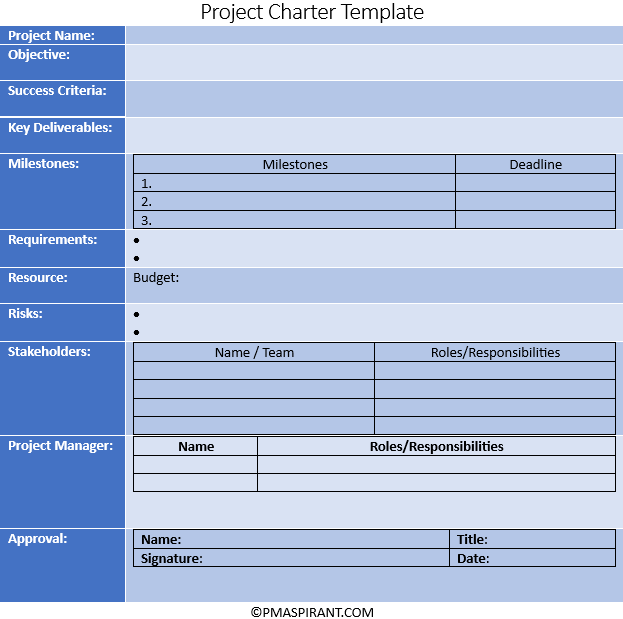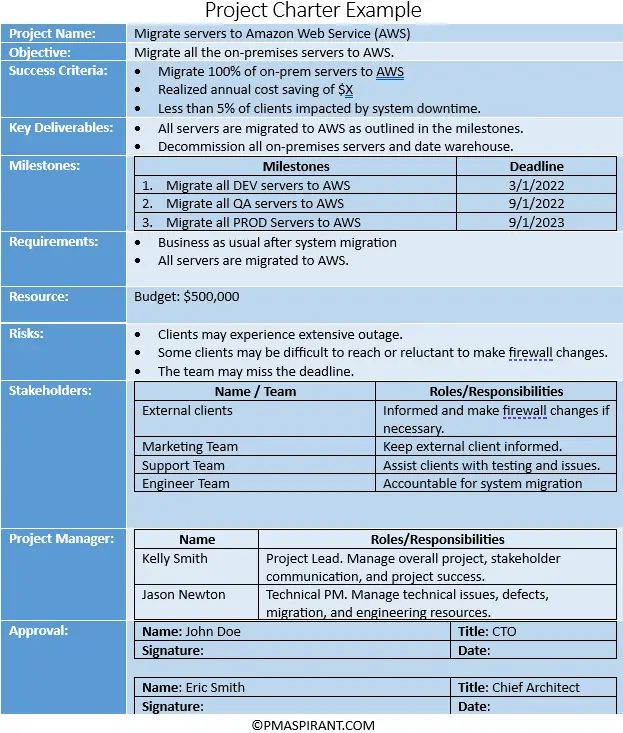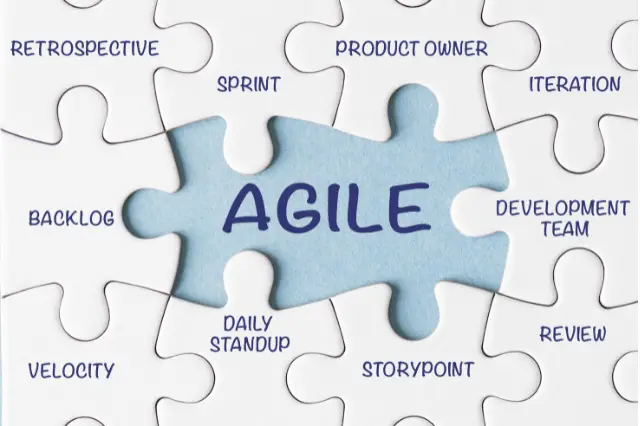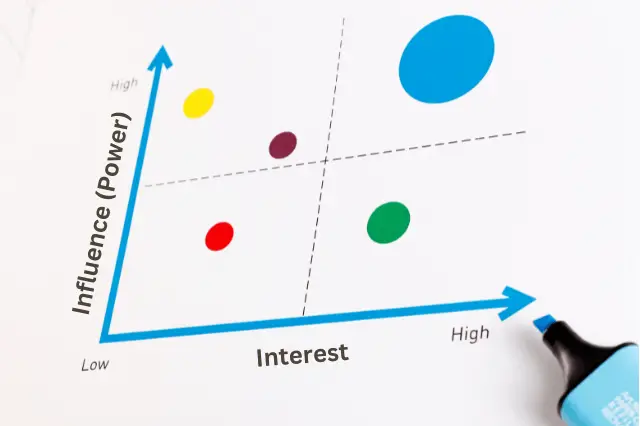Last Updated on November 1, 2024 by andrewshih
Have you ever started a project that went off track or failed to meet its goals?
The key to successful project management lies in two important documents: the project charter and the project plan.
But what exactly distinguishes these two, and why are they both crucial for your project’s success?
In this article, we will delve into the distinct roles and features of a project charter and a project plan, providing you with a clear understanding of how each can significantly enhance your project’s efficiency and success.
- What Is a Project Charter?
- What are the Project Plans?
- Project Charter vs Project Plan
- Benefits of a Project Charter
- Who Writes a Project Charter?
- What Do I Need To Write a Project Charter?
- How to Create a Project Charter Step-by-Step
- Project Charter Template
- Project Charter Example
- Project Charter Example PDF
- Next Step
- FAQ
What Is a Project Charter?
A project charter is a formal document that authorizes the initiation of a project.
It provides a high-level overview of the project, including its purpose, objectives, scope, stakeholders, and key deliverables. The project charter also defines the roles and responsibilities of the project team and grants the project manager the authority to utilize organizational resources.
It ensures that all stakeholders have a shared understanding of the project’s goals and framework, setting the stage for successful project planning and execution.
Key Project Charter Elements
The contents of a project charter vary depending on its purpose. A project charter typically includes details such as:
- Project Title: Clearly state the name of the project.
- Project Description: Provide a brief overview, highlighting its purpose and goals.
- Example: “The ‘New Product Launch’ project aims to introduce our latest product to the market by Q4 2024, targeting a 10% increase in market share.”
- Project Objectives: Outline clear and measurable goals.
- Example: “Increase customer satisfaction by 20% within the first six months post-launch.”
- Scope: Define what is in and out of scope.
- Example: “The project includes market research, product development, and marketing strategy, but excludes post-launch customer service.”
- Deliverables: List the key outputs.
- Example: “Market analysis report, prototype design, marketing campaign materials.”
- Project Milestones: Identify significant progress points.
- Example: “Market research completion by April 2024, prototype ready by June 2024.”
- Budget: Provide an estimated budget.
- Example: “The total budget is $500,000, allocated to research, development, and marketing.”
- Resources: List required resources.
- Example: “Project team, software tools, marketing agency.”
- Stakeholder List: Identify all key stakeholders.
- Example: “Project sponsor, project manager, marketing team, development team.”
- Project Team: List the project team and their roles.
- Example: “John Doe – Project Manager, Jane Smith – Lead Developer.”
- Project Manager Role: Define the project manager’s authority level.
- Example: “Authorized to allocate resources and make project-related decisions.”
- Risks: Identify potential risks and mitigation strategies.
- Example: “Risk: Delayed market analysis. Mitigation: Hire an additional analyst.”
- Assumptions: State project assumptions.
- Example: “Assumes market conditions remain stable.”
A well-written charter can help ensure that all stakeholders understand their roles in delivering successful outcomes for a given project.
What are the Project Plans?
According to PMI’s Project Management Body of Knowledge (PMBOK), A project plan is a comprehensive document that outlines a project’s scope and objectives, as well as the steps stakeholders will take to reach those objectives.
It provides a roadmap for delivering a successful project and guides teams during the execution stage of the project management life cycle. The plan includes considerations for risk management, resource management, communication, scope, cost, and schedule.
Key Project Plan Elements:
- Detailed Scope Statement: Provides an in-depth description of the project scope.
- Work Breakdown Structure (WBS): Breaks down the project into smaller, manageable components and tasks.
- Schedule and Timelines: Detailed project schedule, including start and end dates for tasks and milestones.
- Resource Plan: Identifies resources required, including personnel, equipment, and materials.
- Budget and Cost Management: Detailed budget and cost estimates, including tracking and control mechanisms.
- Quality Management Plan: Defines quality standards and how they will be met.
- Risk Management Plan: Comprehensive risk assessment and mitigation strategies.
- Communication Plan: Outlines communication strategies, stakeholder engagement, and reporting methods.
- Change Management Plan: Procedures for managing changes to the project scope, schedule, and budget.
Project Charter vs Project Plan
The project charter and project management plan are both essential documents for a successful project but there are key differences.
The project charter is issued by the project sponsor, which formally authorizes the existence of the project and gives the project manager permission to allocate organizational resources to complete project activities.
On the other hand, the project management plan outlines how exactly the project will be implemented, monitored, and managed.
Project Charter vs Project Plan Comparison Table
| Aspect | Project Charter | Project Plan |
|---|---|---|
| Purpose | Authorizes the project and defines high-level objectives | Provides detailed execution plan and roadmap |
| Scope | High-level overview of project scope | Detailed description of project scope and tasks |
| Detail Level | High-level and concise | Detailed and comprehensive |
| Timeline | Major milestones | Detailed schedule with timelines |
| Stakeholders | Identifies key stakeholders | Includes detailed stakeholder engagement and communication plan |
| Budget | Estimated budget overview | Detailed budget and cost management |
| Risks | Initial risks and assumptions | Comprehensive risk management plan |
| Usage | Used for initial project approval and authorization | Used as a roadmap for project execution and control |
In summary, while the project charter is essential for getting the project off the ground by providing a high-level overview and formal authorization, the project plan is crucial for day-to-day project management, offering detailed guidance on how to achieve the project’s objectives.
Benefits of a Project Charter
Creating a project charter can be one of the most beneficial parts of a successful project. It serves as a framework to outline the goals, scope, roles and responsibilities, timeline, budget, and resources needed for a successful project outcome.
Some of the benefits include:
-
Providing a document for obtaining upper management approval.
-
Offer a clearer understanding of the scope and goals of the project.
-
Allow for greater collaboration amongst all stakeholders involved.
-
Set expectations for the group.
-
Help to ensure that everyone remains focused.
Who Writes a Project Charter?
The project manager is typically responsible for drafting the charter, while the project sponsor authorizes it and signs off on it.
The project sponsor, who must be at an appropriate level to fund the project, is ultimately responsible for authorizing the charter and allocating budgetary resources.
Meanwhile, the project manager knows the intricate details of charters and can draft a comprehensive document that meets all necessary requirements. Once complete, the sponsor must sign to give official approval.
What Do I Need To Write a Project Charter?
Input
Creating a project charter involves using a range of inputs, such as agreements, business cases, enterprise environmental factors, and organizational process assets, to create an effective framework for the project.
Tools & Technique
To ensure the project charter accurately reflects this information, there are various tools and techniques you can use, such as expert judgment, brainstorming meetings, focus groups, and interviews, along with conflict management and facilitation.
How to Create a Project Charter Step-by-Step
Creating a project charter is a crucial step in project management. Here’s a step-by-step guide to help you develop an effective project charter:
Step 1: Identify the Project Vision
- Define the Project Vision: Clearly articulate what the project aims to achieve and its overall purpose.
- Document Objectives: Outline the specific, measurable objectives that align with the project vision.
Step 2: Define Project Scope
- Scope Statement: Write a detailed scope statement that defines the boundaries of the project.
- Inclusions and Exclusions: Specify what is included and excluded in the project scope to avoid misunderstandings and scope creep.
Step 3: Identify Key Stakeholders
- List Stakeholders: Identify all individuals and groups affected by the project or who have an interest in its outcome. Involve all major stakeholders from the beginning to gather their input and ensure their needs are considered.
- Roles and Responsibilities: Define the roles and responsibilities of each stakeholder.
Step 4: Define Project Deliverables
- List Deliverables: Enumerate the key deliverables the project will produce.
- Deliverable Descriptions: Provide detailed descriptions of each deliverable, including any critical success factors.
Step 5: Outline Project Milestones
- Identify Milestones: List the significant milestones that mark the completion of major phases or tasks within the project.
- Timeline for Milestones: Include dates or timeframes for when each milestone should be achieved.
Step 6: Develop a High-Level Project Timeline
- Project Phases: Break the project into major phases and outline the timeline for each.
- Key Dates: Highlight key dates, such as the project start date, major milestones, and the project end date.
Step 7: Estimate Project Budget
- Cost Estimation: Provide an estimated budget for the project, including major cost components.
- Funding Sources: Identify any funding sources if applicable.
Step 8: Identify Project Risks and Assumptions
- Risk Identification: List potential risks that could impact the project.
- Mitigation Strategies: Outline strategies for mitigating identified risks.
- Assumptions: Document any assumptions that are being made for the project.
Step 9: Define Project Team and Roles
- Team Members: Identify the project team members and their specific roles.
- Authority Levels: Specify the authority levels for decision-making within the project team.
Step 10: Obtain Approvals
- Review Draft: Share the draft project charter with key stakeholders and revise as necessary based on feedback.
- Formal Approval: Obtain formal approval from the project sponsor and key stakeholders to authorize the project.
Step 11: Communicate the Project Charter
- Distribution: Distribute the approved project charter to all stakeholders to ensure everyone is aligned with the project’s objectives and plan.
- Document Storage: Store the project charter in an accessible location for reference throughout the project lifecycle.
By following these steps, you can create a comprehensive project charter that serves as a solid foundation for your project’s success.
Project Charter Template
There can be different variations of project charter templates and examples. Here is a project charter template for reference:

Project Charter Example
Here is a completed project charter example using the template above.

Project Charter Example PDF
If you like the example above, you can download the project charter example and template in PDF format.
Next Step
Let us know if you have any questions about the project charter.
If you have completed the project charter and are ready to manage the project scope, you may want to learn more about Work Breakdown Structure (WBS) next.
FAQ
Why is a Project Charter Important?
A project charter is crucial because it formally recognizes the existence of a project, outlines the key objectives, and grants the project manager the authority to utilize resources. It helps ensure that all stakeholders have a shared understanding of the project’s goals and framework.
What is the difference between a Project Charter and a Statement of Work (SOW)?
There are key differences between a statement of work and a project charter.
A statement of work (SOW) usually serves as an external document between the client or buyer and the organization carrying out the project. SOW is a legally binding contract that outlines what will be included in the project and guarantees it will meet the client’s expectations.
On the other hand, a project charter is mainly for internal use within the organization undertaking the work. The charter clarifies the project and explains who solicited their services in completing it.
Generally speaking, an SOW should be created before drafting up a project charter so that that project can commence once review and approval has been received.
What is the Difference Between a Project Charter and a Business Case?
A business case is created before the project charter and outlines the justification for the project, including the business need, cost-benefit analysis, and expected benefits. The project charter, on the other hand, is a formal authorization of the project, detailing its objectives, scope, and stakeholders.
How Does a Project Charter Help in Stakeholder Communication?
A project charter helps in stakeholder communication by clearly defining the project’s objectives, scope, and deliverables. It ensures that all stakeholders have a common understanding and sets expectations regarding their roles and responsibilities.
What Happens if a Project Does Not Have a Charter?
Without a project charter, a project lacks formal authorization and a clear framework, which can lead to confusion, scope creep, and misalignment among stakeholders. It increases the risk of project failure due to the absence of clear objectives and a structured plan.
How Can a Project Charter Impact Project Success?
A well-defined project charter sets the stage for project success by providing clear direction, aligning stakeholder expectations, and establishing the project manager’s authority. It helps ensure that the project stays on track and meets its objectives.



